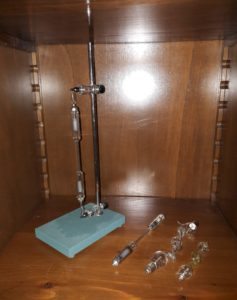
IT – Inventato nel 1857 dal fisico tedesco Heinrich Geissler, esso è un tubo di vetro che può avere le più svariate forme ed è utilizzato per misurare la conduzione di determinati gas. All’interno presenta infatti un gas rarefatto, ha le pareti fluorescenti e una pressione molto inferiore a quella dell’ambiente. Può essere considerato l’antenato dei moderni tubi al neon. Quando una corrente elettrica passa attraverso il tubo, il gas all’interno viene ionizzato, diventando un conduttore, provoca un’intensa emissione luminosa. Diversi gas producono luce di colore differente: l’idrogeno produce una luce rossa, l’acido carbonico una luce verdastra e l’azoto una luce gialla tendente all’arancione.
GB – Geissler tube – Invented in 1857 by the German physicist Heinrich Geissler, it is a glass tube that can have the most varied forms and is used to measure the conduction of certain gases. In fact, it has a rarefied gas inside, has fluorescent walls and a much lower pressure than that of the environment. It can be considered the ancestor of modern neon tubes. When an electric current passes through the tube, the gas inside is ionized, becoming a conductor, causes an intense light emission. Different gases produce light of different colors: hydrogen produces a red light, carbonic acid a greenish light and nitrogen a yellow light tending to orange.